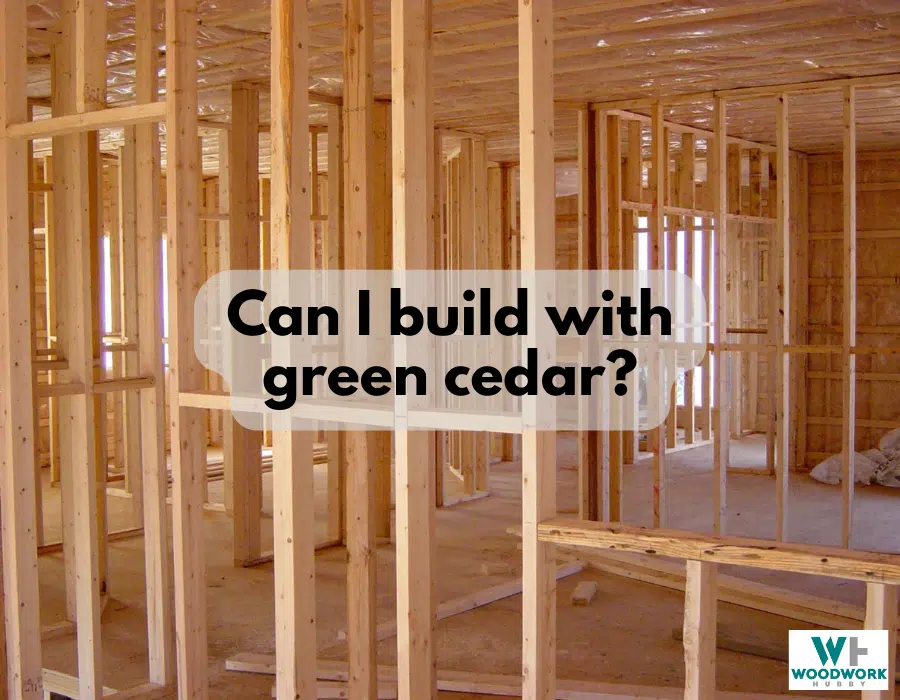I have used dried wood so much in my woodwork that I didn’t really consider green wood as much of an option. Upon accidentally finding a video of green wood construction, I went down a rabbit hole and found myself trying my hand at decking with green cedar. Can you build with green cedar? Here is what I learned.
You can build with green cedar as long as you use metal joints to stabilize the construction and include breathing room in the project specs so that the wood’s shrinkage doesn’t affect the overall project stability. Above all, choosing the right project is crucial to building with green cedar.
In this article, you will find out more about what you can and cannot build with green cedar and how it differs from dried wood. You will also discover the effects of green cedar on the overall project. But first, let’s go over the 10 things I learned from working with green cedar.
- Green cedar doesn’t shrink as much as other greenwood
- Green cedar has a stronger aroma than dried cedar
- Green cedar is easy to cut
- Green cedar resists rotting better than other wood types
- Green cedar joints aren’t as reliable as metal joints
- Green cedar can be used for decking
- Green cedar can be used for fences
- Green cedar can be used for exterior siding
- Green cedar can be used for framing
- Green cedar can be used for roof shingles

Here are some of the other articles I have recently written about working with cedar. I hope you find them interesting as I did.
Can Green Wood Be Used For Framing?
Green wood can be used for framing and has been a preference among many traditional woodworkers. Since framing requires a lot of lumber, producing dry wood would also produce waste. Greenwood with hybrid and mechanical joinery can be used for framing large structures like houses and huts.
However, you need to keep a few things in mind. Firstly, green wood is sometimes not as strong as dry wood. It holds up in framing use cases because multiple beams work in conjunction to hold up a structure. You also need to be mindful of how much the wood might expand or shrink.
Different types of green wood can change volumes to different extents. Finally, you have to be very careful about the overall environment in your region. If things get too hot too quickly, you might want to let green wood air dry a little before using it for framing.
This video teaches you the steps for selecting the right green wood for framing alongside the considerations for construction.
A video teaching the steps for selecting the right green wood for framing alongside the considerations for construction.
Can You Build With Green Logs?
You can build with green logs as long as you make construction choices that do not rely on the wood maintaining its volume and size. Green logs breathe (shrink and expand) throughout their lifespan, and the crafting choices, especially the type of joinery, should make the project movement-proof.
Green logs have been used to build huts, houses, and fences, among other exterior construction projects. To understand how you can use green logs as building blocks for your large-scale project, you must understand how the “greenness” of the log actually affects the overall project.
Dry wood doesn’t change volume, which means you can use 100% woodworking construction and have a relatively stable structure. You can treat wood as dead matter and cut joints that add up mathematically.
For a one-inch pin, you need a one-inch tail to make a dovetail that mathematically adds up. But if you make the same joint with green wood, you can’t be sure that the tail will remain a one-inch wood piece.
It might shrink or expand at a different rate than the pin. This would make the joint loose or too tight.
The shrinkage and expansion of green wood aren’t so drastic that you cannot guess the overall wood length in feet. A 10-foot (3.048 m) spoke, or pillar will remain more or less 10 feet. It’s just the smaller joints that become unreliable.
Anything that you can build without wood joints can be built with green logs. Steel joints are common in large-scale projects that use green logs. The video below shows how the use of steel can lend stability to green log construction.
A video showing how the use of steel can lend stability to green log construction.
Can I Build A Deck With Green Lumber?
You cannot build a deck with green lumber unless the wood has a low shrinkage factor and naturally repels insects and resists rot. Green cedar is a valid choice for decking as it doesn’t shrink enough to warp and can avoid getting infected.
A project made from green lumber has three drawbacks:
- Unreliable joint hold – As green wood dries, the water evaporates at an uneven rate, and the least exposed parts (joints) are the most affected by this. Sometimes, the joints are completely undone. In other instances, they become too tight.
- Uneven shrinkage – Wood can start to appear deformed because of uneven drying. The plainer the wood, the better chance it has of drying evenly.
- Rotting and infestation – Wood with high moisture content is ripe for organic activity. Fungi thrive in wet wood and can survive on green wood. Insects find this wood quite appetizing as well.
Fortunately, decking isn’t vulnerable to most of these drawbacks. For instance, the problem with joints not holding up is irrelevant because deck joints usually leave room for wood to breathe in varying temperatures. Unlike chair and table joints, deck joints can be hybrid or mechanical (using metal parts), which allows the wood to change size without deforming the deck.
Uneven shrinkage isn’t as big a problem either when the entirety of a plank’s surface is exposed to the environment. There is still a shrinkage risk with green lumber, but opting for a relatively stable wood like green cedar can offset that. Choosing pine, cedar, or teak, can also offset the rot and infestation risk associated with common green lumber.
What Happens If You Build With Green Wood?
Green wood is simply wood that hasn’t been dried. Its moisture content can be stabilized with a drying process or be air-dried across a longer period. When you build with green wood, you confine wood to air-drying and depending on how dimensionally stable specific timber is, it can warp.
The more notorious a wood species is for warping, the better it is to avoid green wood from that species. As the water leaves the wood unevenly, greenwood can begin to shrink unevenly, warping and bowing out in the process.
Aside from the instability of dimensions, green wood is also short of internal integrity. A load that would be bearable for the dry version of a specific lumber can internally rupture its green version.
That said, Green Cedar is unlike most green woods in that it is somewhat dimensionally stable. Not all the disadvantages of using green wood apply to using green cedar. The table below covers what happens if you build with greenwood alongside whether these consequences apply to green cedar.
| Effects of building with green wood | Validity for green cedar | Rationale |
|---|---|---|
| The wood shrinks after the project is executed | Yes | Green Cedar can shrink slightly over time |
| The project warps or bows out | Somewhat | Green Cedar maintains its shape in fences, exterior trim, and decking |
| The project has a lower load-bearing capacity | Yes | Even dry cedar isn’t very good at bearing weight. Green Cedar definitely isn’t up to the task. |
| The project can get infested | No | Cedar naturally repels insects that pose the greatest threat to common green wood. |
If you want to learn more if you Can Build With Green Wood, please click on the link to my article provided.
Final Thoughts – Can You Build With Green Cedar?
You can build with green cedar anything that doesn’t require wood to maintain its size down to 0.5 inches. Unfortunately, furniture and small projects with wood joints cannot be constructed with green cedar.
In contrast, projects like large-scale framing and decking can use green cedar since minor shrinkage doesn’t make much of a difference, especially when metal screws are used to hold the structure together.




